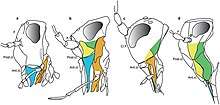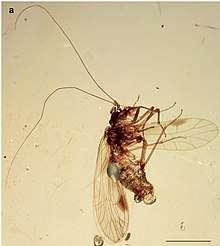Permopsocida
Permopsocida is an extinct order of insects known from the Early Permian to Mid-Cretaceous. It is part of Paraneoptera, alongside bark lice (including lice), bugs and thrips. Within Paraneoptera it is considered to be closer to the clade containing bugs and thrips rather than bark lice, with an estimated divergence during the Late Carboniferous. The group was first named as a suborder by Robert John Tillyard in 1926, and was raised to a full order by Huang et al. in 2016.[1] It is currently divided up into three families, Psocidiidae which is known from the Permian to Liassic. Permopsocidae which is monotypic and only known from the Permian, and Archipsyllidae, which is known from the Late Triassic[2] to mid-Cretaceous (Cenomanian). While most members of the group are known from compression fossils, several members of Archipsyllidae are 3 dimensionally preserved in Burmese amber, which has helped clarify the morphology and phyogenetic position of the group.[1][3][4][5] The morphology of the mouthparts suggests that they were capable of suction feeding and chewing, with preserved angiosperm pollen grains in the gut of Psocorrhyncha suggesting that at least some members of the group were pollenivorous.[1]


| Permopsocida | |
|---|---|
 | |
| Psocorrhyncha burmitica | |
| Scientific classification | |
| Kingdom: | Animalia |
| Phylum: | Arthropoda |
| Class: | Insecta |
| (unranked): | Paraneoptera |
| Order: | †Permopsocida Tillyard, 1926 |
| Families | |
| |

Taxonomy
From:[6]
- †Psocidiidae Tillyard, 1926
- †Ancylopsocus Tillyard, 1926
- †Chaetopsocidium Tillyard, 1926
- †Dichentomum Tillyard, 1926
- †Hypopsylla Prokop, Garrouste & Nel, 2016
- †Liassopsocus Ansorge, 1996
- †Metapsocidium Tillyard, 1926
- †Pentapsocidium Tillyard, 1926
- †Permentomum Tillyard, 1926
- †Progonopsocus Tillyard, 1926
- †Psocidium Tillyard, 1926
- †Permopsocidae Tillyard, 1926
- †Permopsocus Tillyard, 1926
- †Archipsyllidae Handlirsch, 1906
- †Archipsylla Handlirsch, 1908
- †Archipsyllodes Vishniakova, 1976
- †Archipsyllopsis Vishniakova, 1976
- †Bittacopsocus Beutel et al. 2019
- †Burmopsylla Liang, Zhang & Liu, 2016
- †Dinmopsylla Lambkin, 2018
- †Mydiognathus Yoshizawa & Lienhard, 2016
- †Psocorrhyncha Huang et al. 2016
References
- Huang, Di-Ying; Bechly, Günter; Nel, Patricia; Engel, Michael S.; Prokop, Jakub; Azar, Dany; Cai, Chen-Yang; van de Kamp, Thomas; Staniczek, Arnold H.; Garrouste, Romain; Krogmann, Lars (March 2016). "New fossil insect order Permopsocida elucidates major radiation and evolution of suction feeding in hemimetabolous insects (Hexapoda: Acercaria)". Scientific Reports. 6 (1): 23004. doi:10.1038/srep23004. ISSN 2045-2322. PMC 4785345. PMID 26961785.
- Lambkin, Kevin J. (2018-02-20). "A new genus and species of the family Archipsyllidae (Insecta: Paraneoptera: Permopsocida) from the Late Triassic of Queensland". Zootaxa. 4382 (1): 192. doi:10.11646/zootaxa.4382.1.9. ISSN 1175-5334.
- Yoshizawa, K.; Lienhard, C. (2016). "Bridging the gap between chewing and sucking in the hemipteroid insects:new insights from Cretaceous amber". Zootaxa. 4079 (2): 229. doi:10.11646/zootaxa.4079.2.5. ISSN 1175-5334.
- Liang, F.; Zhang, W.; Liu, X. (2016). "A new genus and species of the paraneopteran family Archipsyllidae in mid-Cretaceous amber of Myanmar". Zootaxa. 4105 (5): 483. doi:10.11646/zootaxa.4105.5.4. ISSN 1175-5334.
- Beutel, R. G.; Prokop, J.; Müller, P.; Pohl, H. (2019). "†Bittacopsocus—a new bizarre genus of †Permopsocida (Insecta) from Burmese Cretaceous amber". Zootaxa. 4576 (2): 357–366. doi:10.11646/zootaxa.4576.2.9. PMID 31715767.
- "Order †Permopsocida". Psocodea Species File (Version 5.0/5.0).